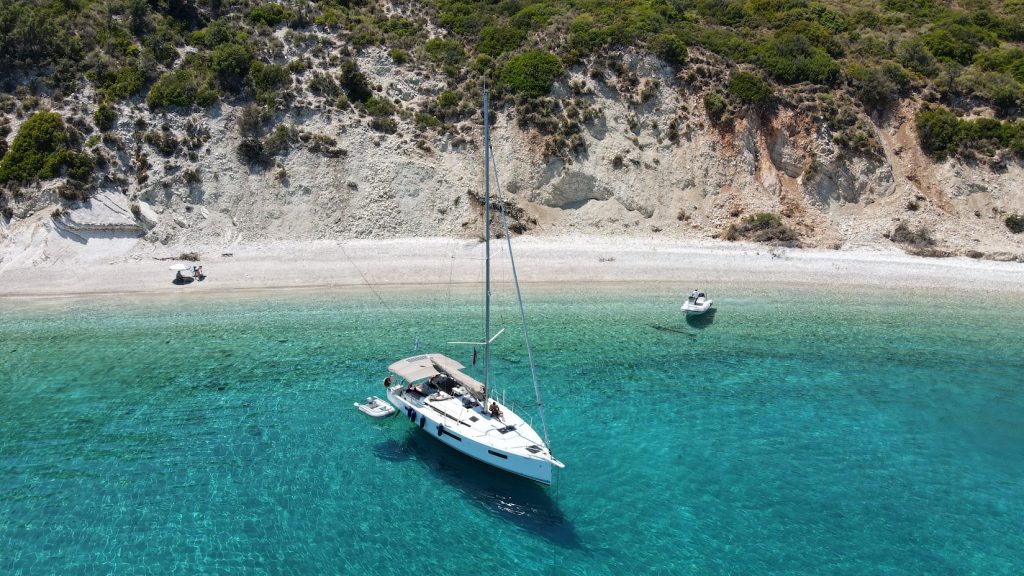The Islands in the Saronic & Argolic Gulf, have an important history and an interesting tradition of many centuries.
Sprinkled over the Argosaronic Gulf and steeped in ancient mythology, these islands are small heavens in close proximity to Athens.
Visitors here will enjoy natural beauty with delightful little ports and coves, historical treasures, unique architecture, and glamorous, yet romantic atmosphere as they were inhabited from the prehistoric era, during which they were greatly developed.
In this sailing area the winds normally are calm and this is why Saronic routes are highly recommended for easy sailing, especially in July and August for avoiding the strong winds blowing in the Cyclades..
You can visit, Aegina, Epidaurus, Poros, Hydra, Spetses, and Salamis, (in a week charter), also Yerakas, Leonidion, Monemvasia, Nafplion. We are sure you will be happy and surprised of the natural beauty, sandy beaches and the friendly people.
In Poros you can always find a nice free place for your yacht, Poros looks like a simple prolongation of Argolis Peloponesse, since the isthmus that separates it from the Mainland of Peloponesse is narrow. You get a feeling that Poros is a small Vosporus. Looking around makes one feel like being embraced by the island and its environment.
Poros lays right in the middle of the Saronic Gulf. You need only short sailing to reach Aegina, Hydra, Methana or Epidauros.
You can get the ferry to Peloponnesus mainland, ready to explore Nafplion, one of the most beautiful towns in Greece, the ancient Mycenae, as well as the Epidavros village and the most famous theatre all over the world, the Ancient theatre of Epidavros.
The town of Hydra is built amphitheatrically to the middle of the north coast of the island, inside a close cove, which is being surrounded by huge rocks.
The first time visitor stays astonished by the imposing Manors that are located to the harbour of the island. Left and right to the entrance lie the bastion with cannons that used to protect the city from attacks. Today the port of Hydra is full of boats that anchor here. There is no transportation in Hydra, except from donkeys that will accompany you to your excursions and anywhere you would like to go. You can visit the Manors and the Museums, walk through the picturesque paths and swim in beautiful beaches such as Hydronetta, Avlaki, Kamini and Spilia, while you are in Hydra. In order to go to other beaches you must go by sea transportation only. The island has got a population of 3.000 and it is known for its natural wild beauty and its hospitality.
Our advice for sailors is to get in the harbor of Hydra early in order to find a free berth in a normally very busy port.
Is located at the entrance of the Bay of Argos. It was first habited in the Early Helladic era (2500 – 2000 B.C.), as certified by the remains of walls, statuettes and clay vessels found at Agia Marina.A luxurious green island, known from the antiquity as Pittioussa – the pine-Clad. The favorite resort of Athenians. Easily reached after a visit to Hydra, Spetses is an attractive destination as well.
Beautiful pebble-beaches, secluded coves, quiet walks in hills, magnificent sunsets, frenzy nightlife.
Meganissi has the magnificent inlet at Port Athene on the north coast.This is the perfect place for snorkelling and swimming and makes a good overnight stop. Vathi is the islands main port. It is a pleasant relaxed place with good walks through the olive groves to the bays on the east.
The high village of Spartohori on can easily be seen from the north and west. Once you are in the bay the small harbour will be seen. Good shelter but the depth often exceeds 15m. The anchorage near the tavern is the best location in the bay. The village of Spartahori is an absolute must, walk up the hill for a warm local welcome and an incredible view out over Nidri, Madhouri and Skorpios and over to the mountains on the mainland to the east. The island has a number of picturesque bays where you can anchor and take a line ashore. Facilities are at best limited and usually non existent Ithaca – Steeped in legend of Odysseus the island has beautiful bays and attractive anchorages.
The oldest archaeological findings from Mycenas are dated around 3000 BC. However, during the alleged Middle Helladic period (1900-1600 BC) the hill was fortified with walls and on the western side there was built a cemetery with tombs inserted in the rock. Around 1600 BC there were built much larger tombs, reserved for distinguished figures. At the same time, they started opening far from the city colossal vaulted tombs, consisting of a long entering corridor and a spacious circular room with a vaulted roof. During the Late Helladic period, the Mycenae were under the sphere of influence of Crete (1600-1500, First Late Helladic Period). Later, Mycenae developed their own civilization, the Mycenean, between 1500 and 1200 BC, which spread to the whole south of Greece, the Mediterranean coasts down to Syria and up to Italy.
Around 1350 BC on the hill of Mycenae there were built new colossal walls, preserved up to the present, which surrounded among others a large number of Royal graves. This was the period of the climax of Mycenaean civilization which reached an abrupt end around 1200 BC after the city was abandoned. Today, Mycenae is one of the loveliest places in Greece, thanks both to its natural beauty as well as to the great charm of the archaeological site, associated with so many myths.
Once, the entrance must have been decorated with two small pillars covered with marble plaster which depicted multicoloured painted representations. Some fragments of these decorations are today kept in the British Museum in London. The burial chamber or Tholos has a diameter of 14.50 metres and it is 13.20 metres high. It is housed by a vaulted roof formed by 33 superimposed courses of joined conglomerate blocks. The vault was adorned with copper rosettes, of which today only a few flowers and small nail holes are preserved. This was certainly a royal grave and it dates from 1330 BC. Therefore, it cannot belong to the victor of Troy VII or even to his father.
The most distant cemetery from the city of Mycenae is the most glorious one, the Treasury of Atreus, as the construction of the “tholos-tombs” was called in antiquity. A long corridor, the dromos, 36 metres long, partly cut into the rock and walled with conglomerate blocks of ashlar masonry leads to a gate 5.40 meters high, surmounted by a lintel and a relieving triangle. The lintel consists of two monolithic architraves, each one literary being a large block of stone, the largest weighing 118 tons.
In a green valley full of springs and streams, 10 kilometres on the west of the city of Epidaurus by the sea, the cult of the waters was practiced since the mycenaean times. Whereas the worship of Apollo-Maleatas continued at a temple on the nearby mountain Kynortion, deep in the valley, near the sacred springs, a new Sanctuary was built especially for the worship of Asklepios. Soon the Sanctuary gained great importace and in the fourth century BC, it was fully restored. At the same time, on the slope of the mountain northeast from the temple, a theatre was built, famous since that time for being the prettiest of all the Greek theatres; this theatre is still preserved in almost excellent condition. The theatere consists of a circular orchestra of 20.28 metres diameter has a centre altar of Dionysus. A small ditch (euripus) runs around its perimeter, in order to collect the rainwater. The cavea has the shape of a fan, with 34 rows of seats, pided into 12 sectors by scales holding approximately 6200 spectators. Beyond the semicircular corridor (diazoma), at a later period, there were added 21 new rows of seats with a capacity of another 14000 spectators. The analogy between the number of rows of the upper and lower diazomae is considered to be mathematically “perfect”. The first and the last row of the lower part and the first of the upper part had seats with backs and these seats were reserved for distinguished citizens.
A complicated set of relationships, largely based on the theory of the golden cut, gave the theatre ideal aesthetic harmony and almost perfect acoustics. The stage that rose behind the orchestra, most of it lost, was supported by 12 Ionic pillars while at each end it had a jutting-out wing. However, during the Hellenistic as well as the Roman period, it underwent several changes that altered its original shape. As it usually happens in Greek theatres, the two spaces between the stage and the cavea (parodoi or passings) were left open to the public due to great circulation. These were adorned with two glorious entrances with Corinthian pillars. Every year at this theatre there took place feasts in honour of Asklepios, including musical and dramatic presentations. In 1954 the theatre was restored into its original shape and since then it hosts every summer the productions of the Epidaurus festival.

Introducing our newest gem to the fleet!
Enjoy special discounts and get to know her while sailing the majestic Ionian Sea!


Use the form below to request availability check for your sailing experience.